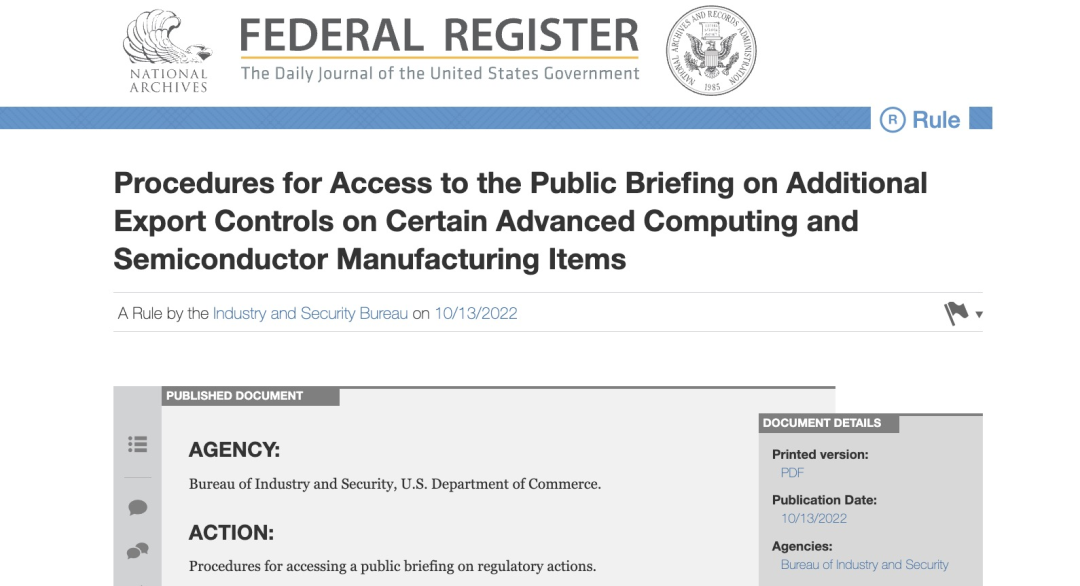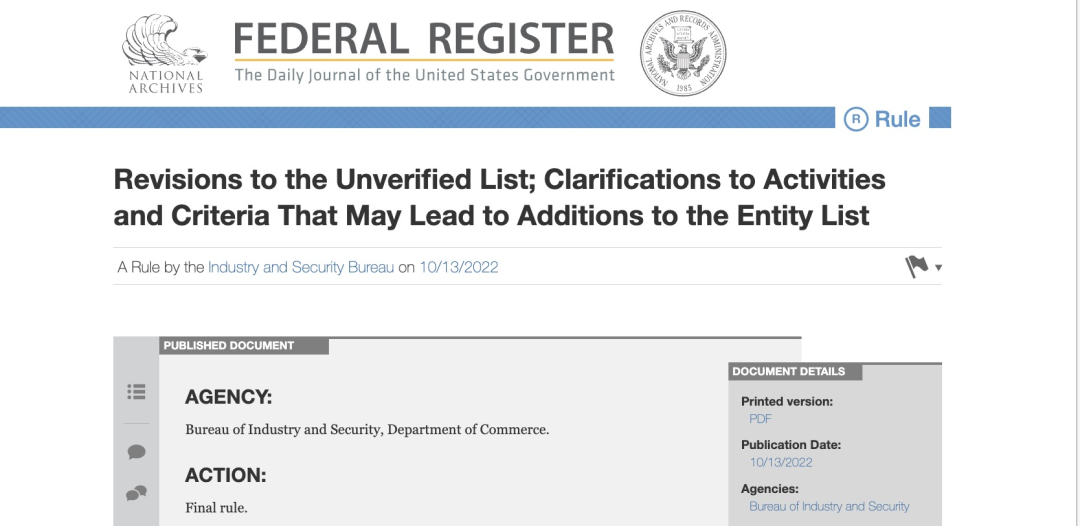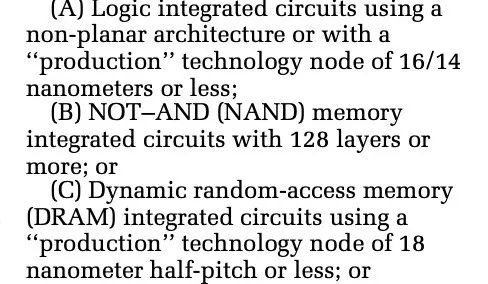An Overview of New US IC Rules
一、 Overview of the New Rules for American Chips
On October 13, 2022, the Bureau of Industry and Security of the U.S. Department of Commerce (hereinafter referred to as "BIS") issued an "Interim final rule" and its supporting documents through the Federal Register, aiming to curb the rapid development of China in the field of advanced computing chip and semiconductor manufacturing, which have now come into force. These documents are:
1. Implementation of Additional Export Controls: Certain Advanced Computing and Semiconductor Manufacturing Items; Supercomputer and Semiconductor End Use; Entity List Modification《实施新增的出口管制:针对某些先进计算和半导体制造物项;超级计算机和半导体的最终用途;实体清单的修改》(以下简称“《实施新规》”)
2. Revisions to the Unverified List; Clarifications to Activities and Criteria that May Lead to Additions to the Entity List《对未经证实清单的修订及可能导致被加入实体清单的活动和标准的进一步澄清》(以下简称“《清单修订》”),以及;
3. Procedures for Access to the Public Briefing on Additional Export Controls on Certain Advanced Computing and Semiconductor Manufacturing Items《关于增加部分先进计算和半导体制造物项的出口管制公开征求意见程序》(以下简称“《公开征求意见程序》”)。



(Screenshot of the Federal Register)
(1) General rules for implementing the new regulations
BIS put forward in the Document of Public Consultation Procedure that "advanced computing products, supercomputers and some semiconductor manufacturing equipment with chips as the main components may be used for the purpose of endangering the national security and foreign policy interests of the United States, including weapons of mass destruction, military modernization and human rights violations", However, "the Chinese government has mobilized a large number of relevant resources to support its national defense modernization, including the implementation of the military civilian integration development strategy, in a way that is contrary to the interests of the US national security and foreign policy". Based on these considerations, the United States needs to further control the export of the above items and related products, and follow the following rules:
1. Add some advanced and high-performance computer chips and computer products containing such chips to the CCL;
2. Add new license requirements for projects that develop and produce supercomputers or semiconductors for use in China;
3. Revise the scope of application of EAR foreign direct product rules, including advanced computing products produced in some countries other than the United States and products used for supercomputer terminals;
4. Expand the scope of production projects in countries other than the United States that require licenses to 28 existing entities located in China;
5. Add some semiconductor manufacturing equipment and related items to the commercial control list;
6. Formulate temporary general license (TGL) to minimize the short-term impact on semiconductor supply chain by allowing specific and limited manufacturing activities in China;
7. New license requirements shall be added to the equipment of semiconductor manufacturing plants manufactured in China that meet the requirements. The facility license owned by the Chinese company will be subject to "constructive rejection", and the company owned facility will make a decision according to the specific situation, specifically involving the following areas:
● Logic chip with non planar transistor structure (FinFET or GAAFET) with a process of 16nm or less than 14nm;
● DRAM memory chip with half space not exceeding 18nm;
● 128 or more layers of NAND flash memory chips;
8. Restrict U.S. entities from supporting the manufacturing, development or production of certain semiconductor factories in China without licenses;
9. Add new license requirements for export projects that develop or produce semiconductor manufacturing equipment and related projects;
(2) Main contents of implementing the new regulations
1. Include advanced computing chips, computer products containing such chips, relevant "software" and "technology", and certain semiconductor manufacturing equipment in the CCL
For advanced computing chips, computer products containing such chips, and related "software" and "technology", three export control classification codes (ECCN codes) - 3A090, 4A090 and 4D090 have been added, which correspond to advanced computing chips, computers equipped with advanced computing chips, electronic components and components respectively, and special software for developing and producing the above computers, electronic components and components. For some semiconductor manufacturing equipment, BIS added ECCN 3B090.
2. Add corresponding license requirements based on RS and AT
Under section 742.6 of the EAR, a new regulation for regional stability (RS) has been established, which requires a license for the export, re export and domestic transfer of certain items to or within China. In addition, if a technology is used to design, develop or produce advanced computer chips and their components and computer products, and the technology is developed by an entity headquartered in China and is a "direct product" of certain software subject to EAR regulations, its export from China to all parts of the world must meet the licensing requirements of the RS control, In addition, the principle of BIS to review such license application is Presumption of Denial.
3A991. p (specifically high-performance chips) and 4A994. l (specifically computers, electronic components and components) and their notes are added under ECCN 3A991 and 4A994 of CCL. These two types of ECCN and their newly added parts are subject to anti-terrorism (AT) control. According to the notes, 3A991. p and 4A994. l also include other high-performance chips and computer related items whose performance does not meet the standards listed in 3A090 and 4A090. Relevant items will be associated with technologies and software of ECCN codes 3D991, 3E991, 4D994 and 4E992. The license requirements of these two items are bounded by the entry into force of these Rules. For the export and re export of technologies and software that did not need a license before but now need a license due to the implementation of these Rules, a license is required only if the acquisition of related technologies or software exceeds the scope of technologies or software legally acquired by foreign nationals before the implementation of these Rules, for example. Foreign citizens who legally acquire the technology or software specified in paragraph 3A991. p or 4A994. l of ECCN before the effective date do not need to apply for a new license. However, if they need to acquire controlled technology or software different from those previously released, they need to apply for a license, regardless of whether such technology or software has been included in the same ECCN code.
3. Revise the Foreign Direct Product Rules (FDPR) (EAR § 734.9 (e)) of the entity list, add advanced computing FDPR and supercomputer end use FDPR (EAR § 734.9 (h) and (i)), and specify different license requirements
The licensing requirements under the Entity List FDPR are: no exceptions apply and the licensing policy is a constructive refusal.
The license requirements under the advanced computing FDPR are: the related items are considered to be controlled by RS, and certain license exceptions can be applied, but the license policy is a constructive refusal. For companies whose end users are countries or regions with headquarters in the United States or A: 5 or A: 6 country groups, the export related items can be approved on a case by case basis. In addition, controlled items will be determined according to technical indicators, and ECCN code is not applicable.
The licensing requirements under the FDPR for the final use of supercomputers are: the latest restrictions on the end users and end uses of supercomputers under Section 744.23 of the EAR will apply, and no licensing exceptions will apply, and the licensing policy is a constructive refusal. For companies whose end users are countries or regions with headquarters in the United States or A: 5 or A: 6 country groups, export related items can be approved on a case by case basis.
4. Establish up-to-date end use and end-user controls for "supercomputers" (EAR § 744.23)
This rule provides two prohibitions in Items (a) and (b). Item (a) provides that if the exporter, re exporter or transshipment party "knows" that the items meeting the product scope will be directly or indirectly used for a specific end use when exporting, re exporting or transferring (at home), the exporter, re exporter or transshipment party shall not conduct the aforementioned export, re export or transshipment (at home), The above-mentioned specific end use refers to the "development" or "production" of integrated circuits in semiconductor manufacturing "facilities" located in China for manufacturing certain integrated circuits.
(b) Item (1) provides a notification clause that the BIS may notify the person concerned, individually or by amending the EAR, of the risks of export conduct and licensing requirements for the activities described in EAR § 744.23. However, the absence of such notice does not exempt compliance with the licensing requirements of EAR § 744.23.
The new item (c) clarifies that the license exception is not applicable under this rule. For example, articles classified as 3A001 can usually be exported to China according to the license exception RPL (for replacing parts), but if it is used for "supercomputers" located in or shipped to China, it does not meet the requirements of the license exception RPL.
5. Revise the list of entities and add 28 Chinese entities, including universities, research institutes, public institutions under the Ministry of Science and Technology, high-tech enterprises, etc. (Supplement No. 4 to Part 744 of the EAR)
The policy issued by the United States further strengthens the connection between the unverified list (UVL) and the entity list. If the United States does not cooperate with the United States in on-site inspection of enterprises listed in UVL, the United States will start to include them in the list of entities 60 days later.
6. Measures to minimize the impact of new regulations
BIS proposed that "considering that the implementation of the new regulations may lead to the interruption of the activities of some companies related to China, especially the transactions related to the supply chain", in order to buffer the impact of the new regulations on relevant industries and business entities, two measures are hereby set:
(1) Certification measures in compliance with the new FDP rules (EAR § 734.9 (h))
The certification link is added in EAR § 734.9 (h) for the exporter, re exporter and transshipment party to determine whether the items to be exported, re exported or transshipped are subject to this rule. The template of the certificate is attached in the Appendix Document No. 3 of Section 734. BIS suggests that if an entity in the supply chain cannot obtain certification, due diligence should be carried out, and the entity may need to obtain BIS authorization to pass items down the supply chain. The certification template is only used to help the subject understand how EAR is applicable to specific items, and obtaining certification does not mean comprehensive due diligence.
(2) Set temporary general license for supply chain (Supplement No. 1 to Part 736)
In the No. 1 appendix document of EAR § 736, BIS specially designed the Temporary General License (TGL) for the supply chain. The TGL is set to avoid the interruption of the supply chain of items covered by ECCN to final customers outside China. From October 21, 2022 to April 7, 2023, enterprises whose headquarters are not located in Group D: 1, D: 5 or E will continue to carry out the integration, assembly (installation), inspection, testing Warranty and distribution. In order to prevent control loopholes such as export, re export, domestic transfer or export of related items from abroad to "end users" or "end consignees" in China, BIS further stipulates that this TGL does not apply to related end users and end use restrictions, and only applies to enterprises engaged in specific activities authorized by this TGL.
二、 The impact of the new regulations of the US chip series on American shareholders and executives of Chinese chip enterprises: stay or leave?
The new regulations may have a greater impact on the activities of Americans in the chip and semiconductor industries. The United States prohibits or restricts "U.S. Persons" working in Chinese semiconductor enterprises, as well as the staff of branches, research institutes, cooperative institutions, etc. established in the United States of China to participate in integrated circuit development activities in China and the final use of semiconductor manufacturing involving China. The activities restricted include a series of activities such as assisting in development and providing services, such as assisting in placing orders; Provide warehousing; Provide loans; Transportation; Freight forwarder.
Who are classified as "U.S. Persons"?
The definition of Americans under the EAR is broad. According to the provisions of EAR § 772, U.S. citizens, U.S. permanent residents, U.S. asylum seekers, legal entities established under the laws of the United States (including foreign branches), and persons located in the United States are included in the category of "U.S. Persons". [6]
The restrictions imposed by the new regulations on the activities of Americans engaged in chip development and semiconductor manufacturing in China are not only clarified in the announcement part of the legislative rules, but also revised EAR § 744.6 and added § 744.23 to indicate that Americans' "support" and "participate" in the development and production of integrated circuits that meet certain specific standards in China will violate the general prohibition in § 744.6,
Americans are not allowed to carry out the following activities on the premise that they know it. Relevant activities must apply to BIS for permission in advance. The specific actions are as follows:
● Transportation, transmission or transshipment of items not subject to EAR control to China, which may be used for the development or production of semiconductor equipment in China and meet the following specifications:
◆ Non planar transistor structure (FinFET or GAAFET) logic chips with a process of less than 16 or 14 nm;
◆ DRAM memory chips with a half space of no more than 18nm;
◆ Develop and manufacture NAND flash memory chips with 128 layers and higher;

● Assist in such transportation, transmission or transshipment or provide services for such activities;
● Transportation, transmission or transshipment to or within China (or assistance in transportation, transmission or transshipment) of any item not subject to EAR control but meeting the parameters of 3B090, 3D001 or 3E001, regardless of its end use or end user;
● Provide services to any item located in China that is not controlled by EAR and meets the parameters of 3B090, 3D001 or 3E001, regardless of its end use or end user;
● When it is impossible to judge whether the relevant technical parameters meet the control standards.
Among the above-mentioned acts, items 1 to 2 do not apply to any licensing exception, and items 3 to 4 can enjoy the relevant exemption when the relevant Americans are employed by the United States government to perform specific official obligations.
三、 Conclusion
The new US export control regulations introduced this time are strict, but they are also an opportunity for local enterprises. On the one hand, due to the constraints of the new US regulations, the capacity and supply of chip manufacturing are in short supply; However, on the other hand, the market demand for smart phones, electric vehicles, smart appliances and other fields will not decrease. What China needs to do now is to strengthen its independent research and development capabilities, gradually reduce its dependence on advanced chips from the United States, and vigorously support and support local enterprises; For local enterprises, there are still good market opportunities to effectively assess the risks they may face according to the new regulations, improve the intellectual property compliance system, and focus on the incubation, protection and compliance of intellectual property in the business process.

 沪公网安备 31010602001694号
沪公网安备 31010602001694号